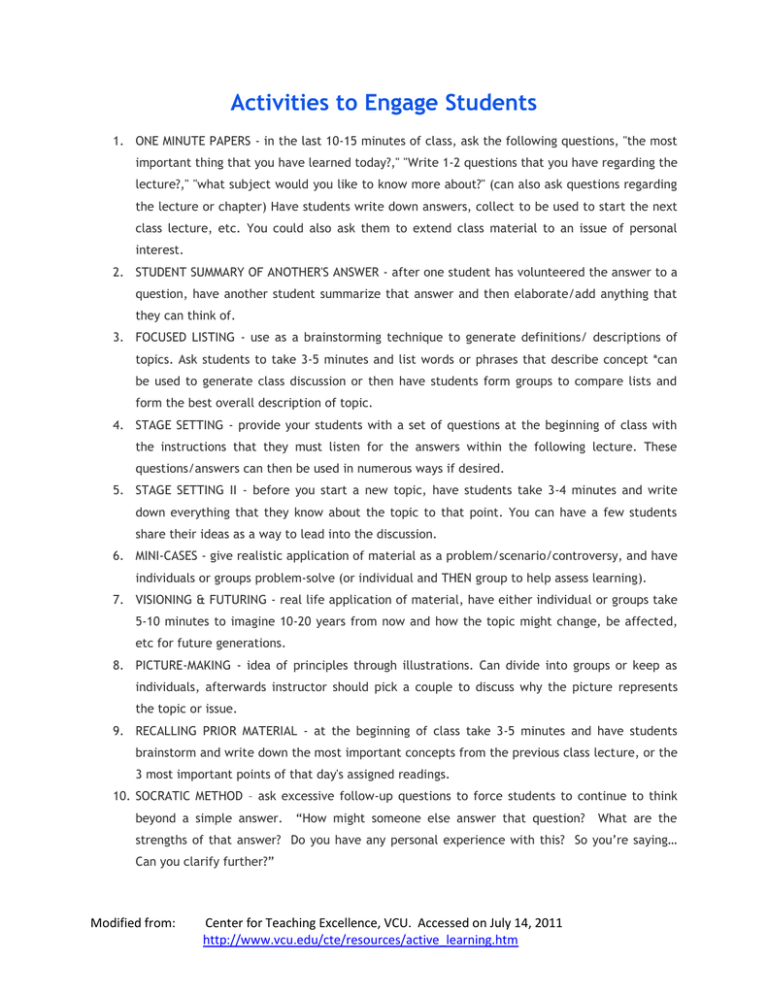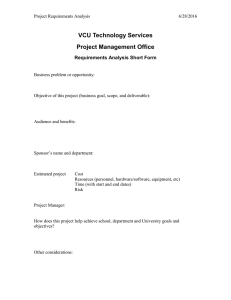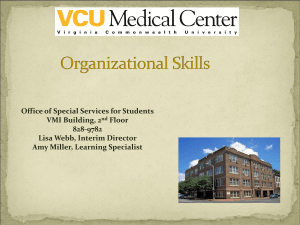Activities to Engage Students - Center for Teaching and Assessment
advertisement

Activities to Engage Students 1. ONE MINUTE PAPERS - in the last 10-15 minutes of class, ask the following questions, "the most important thing that you have learned today?," "Write 1-2 questions that you have regarding the lecture?," "what subject would you like to know more about?" (can also ask questions regarding the lecture or chapter) Have students write down answers, collect to be used to start the next class lecture, etc. You could also ask them to extend class material to an issue of personal interest. 2. STUDENT SUMMARY OF ANOTHER'S ANSWER - after one student has volunteered the answer to a question, have another student summarize that answer and then elaborate/add anything that they can think of. 3. FOCUSED LISTING - use as a brainstorming technique to generate definitions/ descriptions of topics. Ask students to take 3-5 minutes and list words or phrases that describe concept *can be used to generate class discussion or then have students form groups to compare lists and form the best overall description of topic. 4. STAGE SETTING - provide your students with a set of questions at the beginning of class with the instructions that they must listen for the answers within the following lecture. These questions/answers can then be used in numerous ways if desired. 5. STAGE SETTING II - before you start a new topic, have students take 3-4 minutes and write down everything that they know about the topic to that point. You can have a few students share their ideas as a way to lead into the discussion. 6. MINI-CASES - give realistic application of material as a problem/scenario/controversy, and have individuals or groups problem-solve (or individual and THEN group to help assess learning). 7. VISIONING & FUTURING - real life application of material, have either individual or groups take 5-10 minutes to imagine 10-20 years from now and how the topic might change, be affected, etc for future generations. 8. PICTURE-MAKING - idea of principles through illustrations. Can divide into groups or keep as individuals, afterwards instructor should pick a couple to discuss why the picture represents the topic or issue. 9. RECALLING PRIOR MATERIAL - at the beginning of class take 3-5 minutes and have students brainstorm and write down the most important concepts from the previous class lecture, or the 3 most important points of that day's assigned readings. 10. SOCRATIC METHOD – ask excessive follow-up questions to force students to continue to think beyond a simple answer. “How might someone else answer that question? What are the strengths of that answer? Do you have any personal experience with this? So you’re saying… Can you clarify further?” Modified from: Center for Teaching Excellence, VCU. Accessed on July 14, 2011 http://www.vcu.edu/cte/resources/active_learning.htm 11. FINGER SIGNALS/FLASH CARDS - used to immediately test students' comprehension of material. Instructor asks questions (can have yes/no or multiple choice answers), and students respond with finger signals (can have hold in front of torso so no copying). In large classes can have students make up their own cardboard signs with answers (A-D, yes/no) to keep throughout the semester. Not for graded response but allows instructor to see problems with material at a glance and keeps the students involved in the topic-also can have students stand up to answer and get them an opportunity to be out of seats and stretch. 12. EVERYDAY PHENOMENA - short activity, have students take 2-4 minutes to make up a question or 2 about everyday phenomena that could be answered using the material covered that day/by that chapter, etc. 13. THINK, PAIR, SHARE - pose a question to the class, have students think of an answer and write it down. Have students form pairs and discuss responses - randomly call on a few students to share their answers. 14. NOTE TAKING PAIRS - pause periodically during your lecture, take three/five minutes to have students pair up, compare their notes, and highlight the important points. 15. TEAM TROUBLESHOOTING - have students form groups of 3-4, pose a question or problem-ask teams to troubleshoot for 5 minutes and write down their ideas. Stop and collect the papersuse to lead a discussion on an analysis of the issue. 16. NAME YOUR OWN POISON - announce at the beginning of class that you will be giving a pop quiz in the last 10 minutes of class on the material covered. 15 minutes before the end, form teams of 3-4, and have each team make up one quiz question. Collect questions and first give them first question that you have prepared, select 1-2 questions from what they have provided. 17. SEND A PROBLEM - students form groups and each member generates a question on material/social issue/etc and writes it on an index card. Each question is asked to all members of the group until there is a consensus reached regarding the correct answer, which is then written down on the other side of the index cards. Each group sends the question cards to another group. The next group reads each question one at a time and discusses them. If they all agree on the answer, they turn the card over to see if they agree with the 1st group; if so, they proceed to the next question, if not, they write their answer down as an alternative. Once all cards are back to the original groups, discussion of alternative answers, etc is used to clarify material. 18. DRILL-REVIEW PAIRS - four students are grouped together as two pairs. Each pair is given 2 problems/questions to solve. Students are assigned the role of the explainer (gives step-by-step instructions on how to do problem) and an accuracy checker (verifies correctness of methodology used to solve problem). After 1st problem/question is completed, students switch roles for the 2nd problem. After both are complete, both pairs re-group and explain their problems and solutions with each other until a consensus is reached. Modified from: Center for Teaching Excellence, VCU. Accessed on July 14, 2011 http://www.vcu.edu/cte/resources/active_learning.htm 19. PANEL DISCUSSIONS/DEBATES - self-explanatory, can assign for entire class or separate into smaller groups and have the remainder of the class be the judges. 20. ROLE-PLAYING EXERCISES - self-explanatory, can choose certain time periods, or issues with varying viewpoints. 21. PHILOSOPHICAL CHAIRS – Chairs in room are divided into sections representing “Agree,” “Disagree,” and “Undecided” concerning a stance on an issue. Carefully defined rules promote respectful dialogue, and students may move if their view on an issue changes during the activity. Students should be asked to reflect on how their views evolve during discussions. 22. EXPLAINING WRITTEN MATERIAL - instructor hands out a paragraph or article that includes complex concepts/terms, one member of each pair should explain each idea/step to the other. The explainer's partner should ask for clarification if anything is unclear and may give hints but is not to take over the job of explaining. Have one student describe to their partner one of the terms from the reading that is listed on the board, the other must attempt to identify the term being described. Have the students work for several minutes in this way, stop them, call on one or more pairs to summarize their work, and then have the students continue with the roles reversed. 23. THINKING ALOUD PAIR PROBLEM SOLVING (TAPPS) - students are paired and given a series of problems. The two students are given specific roles that switch with each problem: Problem Solver and Listener. The problem solver reads the problem aloud and talks through the solution to the problem. The listener follows all of the problem solver's steps and catches any errors that occur. For the listener to be effective, he or she must also understand the reasoning process behind the steps. This may require the listener to ask questions if the problem solver's thought process becomes unclear. The questions asked, however, should not guide the problem solver to a solution nor should they explicitly highlight a specific error except to comment that an error has been made. 24. CONCEPT MAPS - have students draw/diagram a map connecting the major topic of focus with what they consider its most important features/other ideas and concepts that they have learned/etc-can use for class discussion or group work. 25. MINUTES – one or a few student(s) per class is chosen to take "minutes" of that class period. They must present this information at the beginning of the next class as a quick quiz. Sit these students at the front and other students may be distracted in a constructive way… they pay attention to the material the note taker writes down. 26. JIGSAW - form groups and assign each group part of a chapter/different articles, etc. Each group presents their part to the remainder of the class so that the entirety of the information has been covered. Professor can lead a question and answer session at the end if desired. 27. ONE SENTENCE SUMMARIES - have students answer all of these questions on a specific topic in one long, grammatically correct sentence: Who/What, When, Where, Why, How? Modified from: Center for Teaching Excellence, VCU. Accessed on July 14, 2011 http://www.vcu.edu/cte/resources/active_learning.htm



